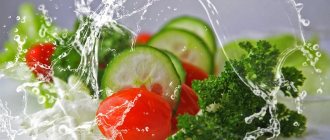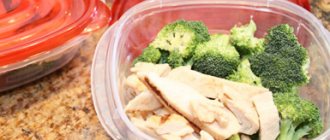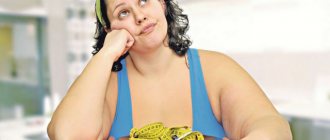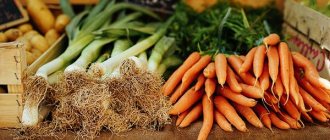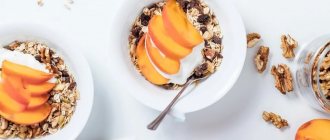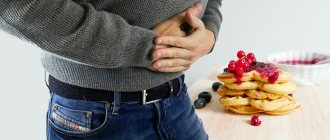Fourteen to sixteen years is the most unpredictable, rapid age, the time of active formation of the endocrine glands. If a correct understanding of food has not been formed before the age of 16, then with age it will be very difficult or almost impossible to change eating habits. And this threatens not only excess weight, but also serious health problems. Due to rapid growth and development at this age, there is an increased need for calories and nutrients.
Therefore, a poor, monotonous diet deprived of parental control can lead to the following problems:
- Dizziness and flashing spots before the eyes.
- Increased fatigue.
- Decreased immunity.
- Caries.
- Joint diseases.
- Bone fragility.
- Menstrual irregularities in girls.
- Decreased performance and concentration.
- Wasting or obesity.
Diet
Poor nutrition will sooner or later lead to health problems.
14–16 years are a time of active growth, which is accompanied by increased appetite. The task of parents is to explain to the teenager the harm of irregular eating dry food, to find an alternative to chips and buns, for example, dried fruits and nuts.
Meals should be four meals a day:
- Breakfast – 25%;
- Lunch – 35–40%,
- Afternoon snack – 15%,
- Dinner – 20–25% of daily nutrient requirements.
- Breakfast should include a snack, main course and drink. As a snack there can be vegetables or fruits, cheese or cottage cheese, eggs, salads. Used as hot porridge, vegetable stew, meat, fish. A drink in the form of hot tea, compote, jelly, milk.
Breakfast options for teenagers:
- Cottage cheese casserole with raisins or chocolate sauce.
- Oatmeal porridge, milk with dried fruits or berries.
- Millet milk porridge with pumpkin, banana, apple or raisins.
- Scrambled eggs, omelet, with meat, green pot or vegetables.
- Curd cheesecakes with sour cream or jam and yogurt.
- Buckwheat milk porridge with vegetables.
- The child often receives lunch at school. It should consist of soup, a second course (side dish with meat or fish), a third course may include a drink with cookies, yogurt, etc.
- For an afternoon snack, you can give your child fruit, cottage cheese, and vegetable salad.
- For dinner you can cook:
- Meat cutlets with vegetables;
- Cottage cheese casserole with apples;
- Omelette with pasta;
- Porridge with dried fruits;
- Dumplings with jam or berries and fruits;
- Fish soufflé with stewed carrots.
Before going to bed, as an option, you can offer a glass of kefir or milk.
The calorie content of food is calculated as follows: approximately 1.8 kcal should be consumed per 1 kg of body weight. This means that a teenager should eat approximately 3000 kcal per day, and with increased physical activity - 3500 kcal. Boys have a particularly high need for energy during this period, and it is not uncommon for those around them to be amazed by their increased appetite.
How much to eat
Nutritionists have calculated the optimal amount of food consumed for a schoolchild:
| Breakfast | Recommended dish weight: 300 g. |
| Dinner | For the first meal, the child should eat 300 g of liquid food, for the second - 300 g of porridge and meat. |
| Afternoon snack | A traditional afternoon snack consists of fruit - 100 g and baked goods - 100 g. |
| Dinner | A light meal is 300 g. |
A 200 ml drink is added to all meals. It can be teas, jelly, berry fruit drinks, cocoa. Avoid giving your teen coffee, as the drink has a high caffeine content.
Proper nutrition of schoolchildren depends entirely on parents. You can teach your child to eat healthy food only by example. Eliminate all foods with artificial additives and dyes from your diet, diversify your menu with meat and fish dishes, and add vegetables. Healthy eating is the key to success in school.
Quality food composition
The qualitative composition of food is as follows: the ratio of proteins, fats and carbohydrates is 1:1:4.
Squirrels
The average protein requirement per 1 kg per day is 2–1.5 g, and 50% of it should be animal protein (beef and poultry, fish, dairy products). It has a primary role because it is a structural material for growth and the immune system, and is necessary for muscle strength. With a lack of protein in the body, the brain suffers, memory and mental abilities decrease, the child gets tired faster, and the immune system cannot cope with infections.
In addition to high levels of protein, dairy products are rich in calcium, and meat is the main source of iron, while fish is rich in phosphorus and minerals.
On a note! Protein content per 100 g of product:
- Meat – 25 g,
- Hard cheese – 25 g,
- Fish – 20 g,
- Milk – 3 g,
- Eggs – 12 g,
- Nuts – 28 g,
- Bread – 8 g,
- Beans and peas – 5 g.
Fats
The daily requirement for fat is about 100 g. For a teenager, the role of fat is to synthesize sex and other steroid hormones. Vegetable oils, butter and sour cream are more useful. Vegetable fats are beneficial due to the content of polyunsaturated fatty acids, and animal fats are beneficial due to fat-soluble vitamins such as A and. 70% of incoming fats should be of vegetable origin and only 30% of animal origin.
On a note! Sources of vegetable fats:
- Vegetable oils (99.9% fat),
- Nuts (50–60%),
- Oatmeal (7%) and buckwheat (3%) cereals.
Sources of animal fats:
- Lard (90% fat),
- Butter (75%),
- Sour cream (about 30%),
- Cheeses (15–30%).
Carbohydrates
The daily requirement for carbohydrates is 10–15 g per 1 kg of body weight (depending on physical activity, ambient temperature, etc.). The main function of carbohydrates is to provide the body's energy needs. Sources of healthy carbohydrates for a child are cereals, vegetables, bread, legumes, greens, fruits, berries, and not buns, cakes and sweets. Vegetables are also the main source of vitamins and minerals, and the dietary fiber they contain normalizes intestinal motility. You can read about how to choose fresh and healthy vegetables and fruits in our relevant articles.
Liquid
The body's need for water in children and adolescents is higher than in adults and amounts to 50 ml per 1 kg of body weight (in adults - 30–40 ml). It is useful to drink mineral water, teas, decoctions of herbs and dried fruits, vegetable and fruit juices. Carbonated drinks are not able to quench thirst, they irritate the gastric mucosa, contribute to the leaching of calcium from bones and teeth, and can cause allergic reactions.
How to lose weight for a teenager at home without harm to health?
Metabolic processes in a young body are more active than in adults, so children lose weight faster. First you need to determine the amount of excess weight, then develop a program of proper nutrition and exercise for the week. It is important that excess weight goes away gradually. The recommended amount is about 3 kg per week. Parents play an important role in the weight loss process. They should help in creating a menu, motivate and support the child, evaluate the changes taking place together with him and rejoice at the successes.
Quickly lose extra 5 kg
Losing weight by 5 kg as a teenager is not difficult; you don’t need an extreme diet with strict restrictions, just a properly balanced menu and regular physical activity. The daily diet should be divided into 5 doses:
- breakfast - porridge with fruit, a slice of bread and tea without sugar;
- lunch - soup or meat with vegetables;
- afternoon snack - fruit or yogurt;
- dinner - cottage cheese or meat and fresh vegetables;
- late dinner - kefir.
Sweets can be replaced with figs, dried apricots, dates, prunes (2-3 pieces during the day). The following physical activities will help you achieve the desired result at home:
- twisting;
- squats;
- walking in the morning and before bed for half an hour.
Physical activity should be introduced gradually and its intensity should also be increased gradually.
Method for losing 10 kg in a week
Rapid weight loss is possible only if there are no contraindications, such as chronic diseases. To lose 10 kg within a week, you need to ensure the correct content of proteins, fats and carbohydrates (BJC) in your diet. Healthy food menu for the week:
| Days | Breakfast | Lunch | Dinner | Afternoon snack | Dinner |
| 1 | oatmeal porridge with honey, plums - 3 pcs., unsweetened green tea | green apple | fish soup with vegetables, a slice of bran yeast-free bread | yogurt, dates - 2 pcs. | steamed beef, salad of tomatoes, cucumbers, sweet peppers, herbs (dressing - lemon juice, salt, linseed oil) |
| 2 | broccoli, buckwheat porridge, cocoa | apricots - 4 pcs. | steamed turkey with cauliflower, sweet peppers, zucchini, asparagus | cottage cheese casserole | grilled or steamed fish, salad of radishes, tomatoes, green onions, parsley (dressing - lemon juice, sesame oil) |
| 3 | Rice porridge with spinach, unsweetened dried fruit compote | cottage cheese and apple | steamed chicken cutlets, fresh carrot, celery, lettuce salad | natural yogurt, cottage cheese, pear | baked hake, salad of Chinese cabbage, cucumbers, green peas with a spoon of olive oil |
| 4 | egg white omelette, tomatoes, bran bread, black tea | vegetable salad (cabbage, apple, carrot) | bulgur with boiled chicken | dried apricots with natural yogurt | steamed beef with vegetables (tomatoes, carrots, onions, zucchini, broccoli) |
| 5 | oatmeal with cottage cheese, strawberries - 10 pcs., fruit drink | green apple | spinach and meatball soup | cottage cheese casserole, green tea | baked white fish with tomatoes and arugula |
| 6 | egg white omelette, boiled rice, green tea | dried apricots, prunes | boiled shrimp or other seafood, fish, seaweed | plums - 4 pcs. | natural yogurt, cottage cheese, apricots - 4 pcs. |
| 7 | millet porridge, banana, unsweetened tea | boiled egg, cucumber | borscht, yeast-free bread | cottage cheese casserole, tea | baked rabbit meat, sauerkraut |
In this mode, the child’s weight is normalized within a month. Intensive training according to the following program will help speed up weight loss:
| Days of the week | Training |
| 1 | Morning and evening walks for 30 minutes. |
| 2 | Tabata workout (exercise for 20 seconds, rest for 10 seconds):
Do 5 more repetitions of the indicated exercises with a five-minute rest between repetitions. |
| 3 | Walking morning and evening for 40 minutes. |
| 4 | Training for all muscle groups:
|
| 5 | Morning and evening walks for 45 minutes. |
| 6 |
|
| 7 | Rest. |
A method for losing weight without dieting or exercise for a teenager
Excess weight in adolescence can be perceived as very painful. The opposite situation is also possible, when the child does not understand that he has a problem.
In both situations, the teenager needs parental support. The child must understand that excess weight can and must be fought. Examples include stories of celebrities who were able to cope with this problem.
It is important for parents of overweight children to remember a few key rules:
- The diet should not contain sweets, chocolate, cakes and other sweets. Tea without sugar, but you can have honey.
- It is required to minimize the amount of pasta and bread in the diet, eat bran bread, fermented milk products, and fish.
- During the day, your child should drink plenty of water to boost metabolism and relieve hunger.
Consumption standards for vitamins, macro- and microelements for a teenager

A teenager must receive the required amount of macro- and microelements and vitamins from food. In the summer, it is enough to eat a variety of fresh vegetables and fruits (berries), and in the winter-spring period you can take a course of vitamin preparations. It is believed that by eating six fruits of different colors a day, we meet the need for all the necessary vitamins and minerals!
Calcium (1.2 g/day) and magnesium (300 mg/day) are needed for building bones and teeth; magnesium also relieves the excitability of the nervous system, helps cope with insomnia, and has a beneficial effect on the heart muscle.
Phosphorus (1.8 g/day) is necessary for metabolism, normal functioning of the nervous system and brain, muscles, liver and kidneys.
Iron (15–18 mg/day) is necessary for hematopoiesis and saturation of the body with oxygen.
Sodium (4 g/day), chlorine and potassium (4 g/day) normalize water-salt metabolism, acid-base balance, potassium removes excess water and sodium from the body.
Iodine (130 mcg/day) is necessary for the normal functioning of the thyroid gland.
Fluoride (2–3 mg/day) is involved in the construction of bones and teeth.
Vitamins are needed for the normal course of metabolic processes and the functioning of the body as a whole. They participate in various biochemical processes, ensure the physical and mental performance of a teenager, and strengthen the immune system.
Daily vitamin intake for teenagers:
- A – 1.5 mg;
- B1 – 1.8 mg;
- B2 – 2.5 mg;
- B6 – 2.0 mg;
- B12 – 3.0 mcg;
- RR – 19 mg;
- C – 75 mg;
- E – 15 mg;
- D – 2.5 mg.
Weight and height standards for teenagers 14–16 years old
| Age | Girls | Boys | ||
| Height/cm | Weight, kg | Height/cm | Weight, kg | |
| 14 years | 155,4–163,6 | 48,2–58,0 | 156,2–167,7 | 42,8–56,6 |
| 15 years | 157,2–166,0 | 50,6–60,4 | 162,5–173,5 | 48,3–62,8 |
| 16 years | 158,0–166,8 | 51,8–61,3 | 166,8–177,8 | 54,0–69,6 |
Diet for weight loss for teenagers 14–16 years old
To estimate body weight, it is necessary to calculate the body mass index (BMI = the ratio of body weight in kg to height in square meters). With a balanced diet, the normal BMI is 20–25 kg/m2. If the BMI is less than 18.5 kg/m2, it means that the teenager’s body needs additional energy; if the BMI value is 25–30 kg/m2, there is excess body weight, and values more than 30 kg/m2 indicate obesity, therefore, energy with There is a lot of food intake, but not enough physical activity, which risks heart, liver and kidney diseases, and diabetes.
First and most importantly: the teenage diet is simply the exclusion of harmful foods, those that, in principle, are useful for a person of any age to avoid. In a teenage diet, it is important to understand that due to accelerated metabolism, it is easier to lose weight than for adults; you just need to eat a varied and nutritious diet. What does it mean:
- Reduce food intake by a fifth.
- Eliminate harmful foods (the list is provided below), replacing them with protein-containing ones (meat, fish, dairy products, legumes). Add physical activity.
- The cause of extra pounds in teenagers, as a rule, is excessive and unhealthy eating, so the first thing you need to do is stop forcing your child to finish eating when he is already full.
- Before going on a diet, make sure your child is actually overweight.
- Never force your child to go on a diet if he does not want to.
- If a child who is truly overweight decides to go on a diet himself, support him in this, create a varied menu with him, or take part in this diet yourself.
- Have dinner no later than 18–19 hours;
- 30 minutes before meals, teach yourself to drink a glass of water;
- You should eat fractionally (6 times a day) in small portions, so as not to accustom your stomach to large volumes;
- The afternoon snack and dinner taken together should not exceed lunch in calories. Find out more about the calorie content of foods here.
The importance of proteins
Since school, we have heard more than once that proteins are the main building material of the body. However, what does this phrase mean?
First, almost every substance inside our body is made of protein. Hormones are proteins, blood clotting factors, thanks to which we do not bleed at the slightest injury - also proteins, RNA and DNA, which contain hereditary information - again protein, hemoglobin, which transports oxygen to cells and tissues, also has a protein structure.
Secondly, proteins are made up of amino acids, eight of which are essential. That is why they are called “essential”, since they can only be obtained from the outside, with food. They cannot be synthesized in the body by themselves. And amino acids are not only the “building blocks” of our body, but also the most important component of water exchange between cells and tissues. By creating pressure in the blood vessels, which is called oncotic, proteins prevent the flow of water from the blood into the cells, preventing their swelling and death.
Thus, the presence of protein in the diet is extremely important.
Exception
Products that become the main cause of obesity in adolescents, i.e. they should be completely excluded from consumption:
- Chips, soda, chocolate bars and candies.
- Industrially produced sauces (ketchups, mayonnaise, adjika, etc.).
- Processed meat products (sausage, ham, frankfurters).
- Bakery products and fast food.
- Fried food (especially cutlets and potatoes, fried pies).
You should eat mostly home-cooked food. Vegetable soups, cereal porridges (you shouldn’t get carried away with semolina and oatmeal), bread, seafood, dairy products (whole milk and kefir, cheese and cottage cheese), eggs, weak tea, it is important to stew and bake chicken, lean pork, beef. Potatoes can be consumed no more than twice a week, boiled or baked. Pasta can only be eaten from durum wheat. Do not overuse sweet and starchy foods.
In a teenage diet, you can arrange fasting days, on which you can eat kefir, buckwheat with water and fresh/baked fruits. But it is recommended to arrange such days a maximum of one day a week. Calorie content – up to 1000 per day. A more significant decrease in nutritional value and, especially, complete hunger on fasting days will cause various disorders in the teenager’s body, including overstimulation of the appetite center in the brain, which can lead to a breakdown: the child will eat everything around and eventually gain more than he lost before. .
Physical activity plays a significant role; doing something for two hours two to three times a week will be enough. Any sport is suitable, as long as it brings pleasure to the teenager (running or swimming, yoga or dancing, rollerblading or skating, skiing, wrestling and boxing, team sports, football, volleyball - the list goes on and on).
Indications
Diets for teenagers should be aimed at limiting the entry of fat into the body and inhibiting its deposition around internal organs. Many teenage diets are “quick”; their essence is to urgently destroy fat deposits in the body by reducing the caloric content of the diet. The body of a teenager is not fully formed, and for the proper functioning of all organs and tissues, a certain ratio and amount of fats, proteins and carbohydrates are required. Therefore, such a diet should be based on a balanced and nutritious diet.
Diet menu for teenagers

Calorie content: daily calorie intake should be reduced by no more than 20%. This means: girls - approximately 2500 calories per day, and boys - 3000. Moreover, if the child is actively involved in sports, we increase this calorie content by 20%.
Daily diet: 30% fat, 20% protein, 50% carbohydrates.
For breakfast you can serve:
- croutons with hard cheese / 1 soft-boiled egg or omelette / cottage cheese casserole with fruit or rice / buckwheat porridge;
- 1 tomato or cucumber;
- tea/milk/kefir.
For second breakfast:
- low-fat yogurt;
- fruit/vegetable
Lunch should consist of the first, second and third:
- vegetable soup;
- spaghetti/stewed vegetables/baked potatoes/porridge with meat;
- vegetable salad (seasoned with vegetable oil);
- juice/tea/compote.
Perfect for an afternoon snack:
- 1 vegetable;
- a glass of kefir.
Dinner:
- fish baked with vegetables/cottage cheese with dried fruits and sour cream/vegetable salad with a piece of meat;
- a glass of juice.
The outcome of constant unhealthy diets
Poor nutrition in youth destroys bones in old age
The cause of joint diseases (arthrosis) in old age is a diet with insufficient calcium and vitamin D in childhood.
The likelihood of developing osteoporosis increases in adolescents who exhaust themselves with diets, especially in girls suffering from eating disorders. Girls are still at risk of bone tissue destruction, since at this age active growth and formation of the skeleton occurs, and prolonged fasting can negatively affect this process.
If a girl’s diet is varied and balanced, rich in calcium, protein and vitamin D, this will reduce the risk of osteoporosis in the future.
Delayed puberty
ZPR occurs with a lack of body weight (unbalanced diet, low calorie food, diet, fasting) or, conversely, with obesity. Delayed puberty can occur with intense sports activities if the teenager eats little.
Anorexia
One of the sad consequences of incorrect fanatical diets is anorexia, which turns the human body into a skeleton covered with skin. Usually girls who are dissatisfied with their appearance bring themselves to this state. First, diets appear, then refusal to eat at all, inducing vomiting, taking laxatives and diuretics.
Interesting to know. Anorexia is the most common mental illness of adolescence. 50% of girls think they are overweight. 80% of girls this age have already been on a diet at least once. 2–4% of girls suffer from anorexia. Anorexia ranks first in terms of mortality from mental illness.
What parents need to pay attention to if they suspect anorexia in their child:
- sudden weight loss within a month;
- weakness, fatigue, irritability;
- frequent mood changes;
- refusal to eat with family or friends;
- disappearance after a feast (monitor your child if you suspect that he is vomiting after eating);
- disruptions in the menstrual cycle, cessation of menstruation;
- obsession with appearance and nutrition;
- sleep disturbance;
- constant cold and chills;
- increased physical activity in the absence of adequate nutrition.
In addition to the outwardly terrifying appearance, anorexia causes problems with the functioning of the kidneys and gastrointestinal tract, osteoporosis and anemia develop, disruptions in the functioning of the heart and central nervous system may occur, and the mind also suffers.
Food schedule
Meal times are greatly influenced by changes in a child's education. If a student attends classes during the first shift, then the best option for meals would be the following hours:
- breakfast 7:00 - 8:00;
- lunch 10:00 - 11:00;
- lunch 13:00 - 14:00;
- dinner 18:00 - 19:00.
For those who go to school during the second shift, you need to eat at the following times:
- breakfast 8:00 - 9:00;
- lunch 12:00 - 13:00;
- afternoon tea 16:00 - 17:00;
- dinner 19:00 - 20:00.
Do not forget about the basic rules of dietetics; lunch and breakfast together account for about 60% of the total daily calorie intake. Evening meals are taken no later than two hours before bedtime.

Diets for the main physiological problems of adolescence
Diet rich in iron-containing foods
Boys especially need iron to maintain rapid growth, because during this period muscle mass doubles, and girls need it not only to maintain growth, but also to replenish blood loss during menstruation.
The diet includes the following products:
- Sea fish and seafood.
- Beef.
- Beans, peas, beans.
- Buckwheat.
- White cabbage.
- Spinach.
- Hematogen.
Basic Rules:
- In the human body, iron is absorbed with the help of vitamin C, so when consuming iron-containing foods, it is important to combine them with sources of vitamin C (citrus fruits, rose hips, apples, peaches, sweet red peppers, berries, peas, etc.).
- Do not consume foods that reduce iron absorption: black and green tea, coffee, mint, chamomile.
Diet for night blindness
The main cause of night blindness is a lack of vitamins A, B2 and PP. Also, ophthalmologists do not recommend that teenagers go on diets that exclude meat and fish from the diet.
Products needed for a teenager suffering from night blindness:
- Vegetables and fruits of red and yellow color: pumpkin, carrots, sweet peppers, sea buckthorn, gooseberries, currants, cherries, apricots.
- Liver (beef and pork), fish, legumes.
- Greens: spinach, celery, green onions and parsley.
- It is also recommended that children with this problem eat egg yolk, cheese, cream, and butter every day.
- If possible, it is good to eat black and red caviar, cod liver and fish oil.
- It is recommended to drink rosehip decoction in courses.

